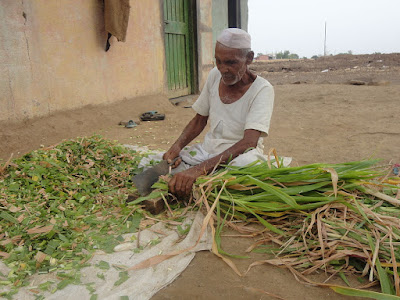 |
| Glaciers at the Taboche summit, Nepal, have been reduced by warming / bonn_4 / CC-BY-SA 2.0 |
धरती के वायुमंडल
में ग्रीन हाउस गैस का स्तर पिछले 8 लाख वर्षों में उच्चतम स्तर पर पहुंच गया
है. 1901 से 2017 के बीच, भारत का औसत वार्षिक
तापमान लगभग 1.2 डिग्री सेल्सियस बढ़ गया है। (By 2100) हम 3 से 4 डिग्री सेल्सियस के
औसत तापमान वृद्धि की ओर बढ़ रहे हैं.
(From another report) even a 1°C rise in global mean temperature (compared to the
1990s) will mean that about 8 per cent of the global population will see a
severe reduction in water resources, according to an Intergovernmental Panel on
Climate Change (IPCC) estimate.
Some newspaper reports have made
it sound in the last 2-3 years as if India was providing global leadership on
climate change. Therefore, I was shocked to read the report by CSE on state action
plans on climate change, prepared between 2009 and 2014. Four of the States whose
plans were analyzed, were ruled by BJP, and 4 by other parties, including one
by Congress. The Central Govt. was then headed by the Congress party.
 |
| Ploughing with cattle in West Bengal / ILRI / CC-BY-SA 2.0 |
 |
| Monsoon clouds, Lucknow, Uttar Pradesh, India / Sunnyoraish |
एक और
उदाहरण में, गुजरात में राज्य का सबसे लम्बा समुद्र तट
है, जिसमें गुजरात की 37 प्रतिशत जनसंख्या निवास करती है और ये
आर्थिक रूप से भी बहुत महत्वपूर्ण है। इसको जलवायु परिवर्तन से होने वाले कई खतरे
जैसे बढ़ता समुद्री जल स्तर, जलप्लावन, चक्रवाती तूफान की स्थिति में बाढ़, खारे पानी की घुसपैठ आदि है। लेकिन, इन सबके बावजूद भी तटीय क्षेत्र प्रबंधन
को राज्य के एसएपीसीसी में सही तरह से सम्मिलित नहीं किया गया और लगभग पूरी तरह
नजरअंदाज कर दिया गया।
 |
| Farmer in India / Azhar feder / CC-BY-SA 3.0 |
++++++++++++++++++++++
So
this is one more area where the Congress Govt. at the centre was unable to provide
leadership to the country in the end. Jairam Ramesh had set good standards of
engagement and understanding on many areas of the environment. But he was removed
reportedly because he was not compliant enough to greenlight industries that
would not meet environmental crieteria. Under Jayanti Natarajan thereafter and
then Moily, it all seems to have gone downhill.
No comments:
Post a Comment